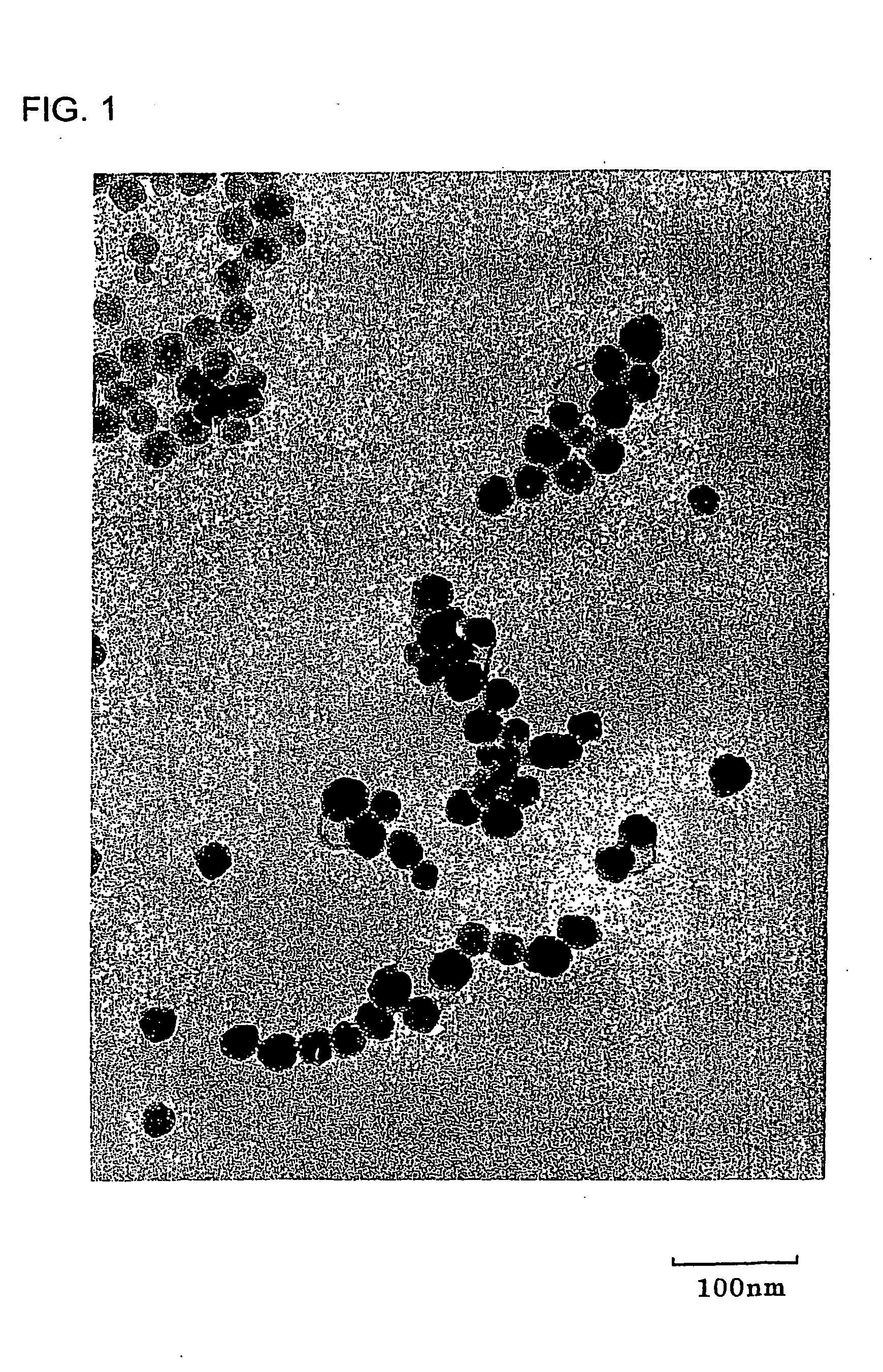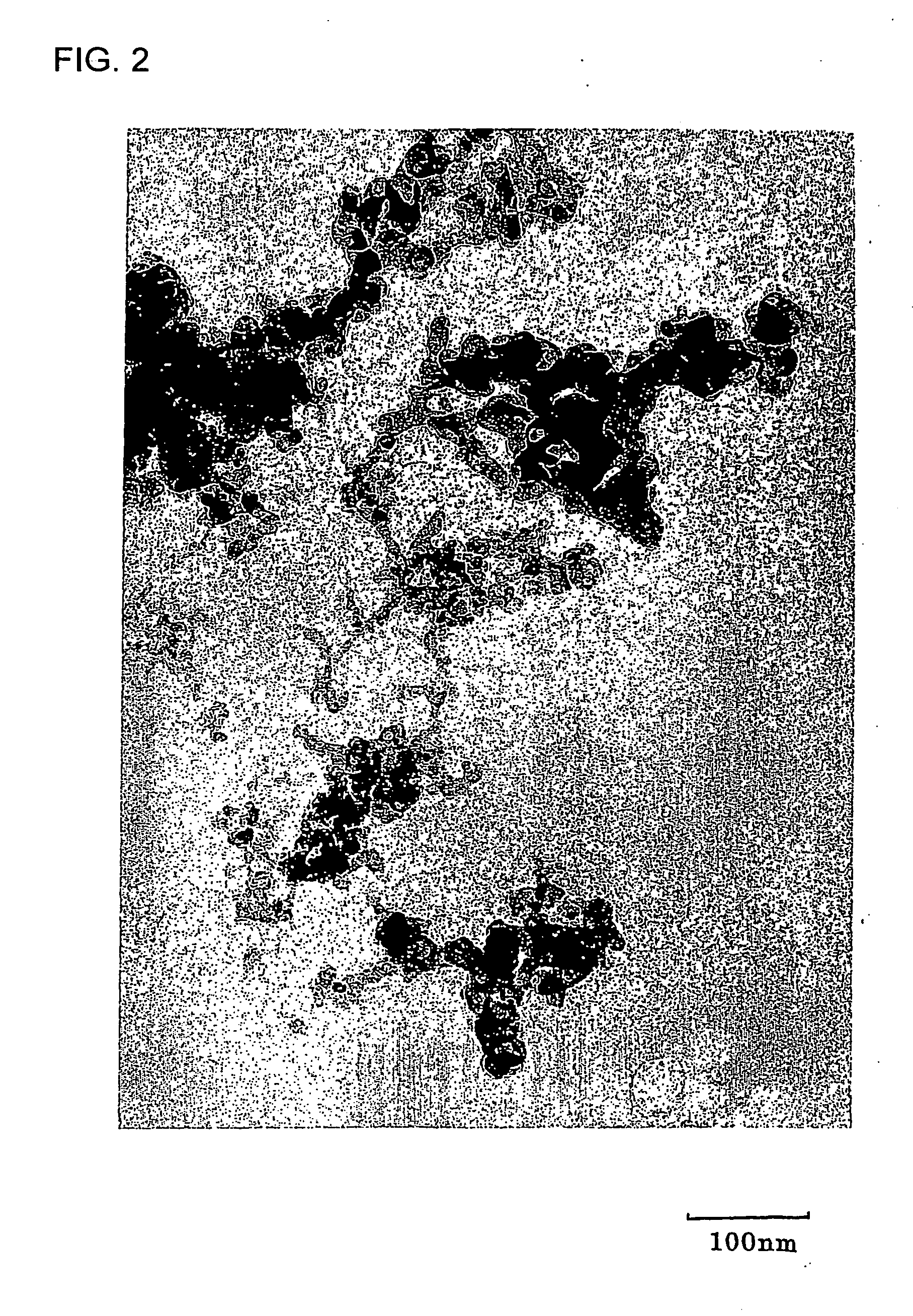Composite sol, process for producing the same, and ink-jet recording medium
a sol and composite technology, applied in the field of composite sol, can solve the problems of sol conjugation, sol physical properties or stability, and patents that do not disclose the shape of composite particles, and achieve excellent color development, good ink absorption, and high surface hardness
- Summary
- Abstract
- Description
- Claims
- Application Information
AI Technical Summary
Benefits of technology
Problems solved by technology
Method used
Image
Examples
example 1
[0116]To 10 L-glass container, were added 469 g (SiO2 content: 164.2 g) of alkaline silica sol having a specific surface area diameter (particle diameter measured by nitrogen absorption method) of 22.0 nm (SNOWTEX M-30 (trade name) manufactured by Nissan Chemical Industries, Ltd., specific gravity: 1.248, viscosity: 7.8 mPa·s, pH 9.7, electric conductance: 1885 μS / cm, silica concentration: 35.1% by weight, Na2O concentration: 0.16% by weight) and 3000 g of pure water, and 19.4 g (H3PO4 content: 16.5 g) of 85% aqueous solution of phosphoric acid was added thereto with stirring by Disper type agitator at 1500 rpm and continued stirring for 20 minutes to obtain a mixture liquid (a) (pH 1.96, silica concentration: 4.71% by weight, phosphoric acid (H3PO4) concentration: 0.473% by weigh). At this stage, little change in transparence of sol and colloid color (whiteness) was confirmed and little aggregation of colloidal silica particles was confirmed by an observation with electron microsco...
example 2
[0126]To 10 L-glass container, were added 629 g (SiO2 content: 127.1 g) of acid silica sol having a specific surface area diameter (particle diameter measured by nitrogen absorption method) of 11.0 nm (SNOWTEX O (trade name) manufactured by Nissan Chemical Industries, Ltd., specific gravity: 1.127, viscosity: 2.2 mPa·s, pH 2.5, electric conductance: 439 μS / cm, silica concentration: 20.2% by weight, Na2O (in colloidal silica particles) concentration: 0.03% by weight, chlorine ion concentration: 10 ppm or less, sulfuric ion concentration: 10 ppm or less, particle diameter measured by dynamic light scattering method: 20 nm) and 2800 g of pure water, and 29.8 g (H3PO4 content: 25.3 g) of 85% aqueous solution of phosphoric acid was added thereto with stirring by Disper type agitator at 1500 rpm and continued stirring for 20 minutes to obtain a mixture liquid (a) (pH 1.84, silica concentration: 3.67% by weight, phosphoric acid (H3PO4) concentration: 0.73% by weigh). At this stage, little ...
example 3
[0134]To 10 L-glass container, were added 410 g (SiO2 content: 166.1 g) of acid silica sol having a specific surface area diameter (particle diameter measured by nitrogen absorption method) of 21.5 nm (SNOWTEX O-40 (trade name) manufactured by Nissan Chemical Industries, Ltd., specific gravity: 1.290, viscosity: 4.1 mPa·s, pH 2.65, electric conductance: 950 μS / cm, silica concentration: 40.5% by weight, Na2O (in colloidal silica particles) concentration: 0.13% by weight, particle diameter measured by dynamic light scattering method: 36.5 nm) and 3000 g of pure water, and 16.9 g (H3PO4 content: 14.37 g) of 85% aqueous solution of phosphoric acid was added thereto with stirring by Disper type agitator at 1500 rpm and continued stirring for 10 minutes to obtain a mixture liquid (a) (pH 1.86, silica concentration: 4.85% by weight, phosphoric acid (H3PO4) concentration: 0.419% by weigh). At this stage, little change in transparence of sol and colloid color (whiteness) was confirmed and li...
PUM
| Property | Measurement | Unit |
|---|---|---|
| specific surface area diameter | aaaaa | aaaaa |
| particle diameter | aaaaa | aaaaa |
| pH | aaaaa | aaaaa |
Abstract
Description
Claims
Application Information
 Login to View More
Login to View More - R&D
- Intellectual Property
- Life Sciences
- Materials
- Tech Scout
- Unparalleled Data Quality
- Higher Quality Content
- 60% Fewer Hallucinations
Browse by: Latest US Patents, China's latest patents, Technical Efficacy Thesaurus, Application Domain, Technology Topic, Popular Technical Reports.
© 2025 PatSnap. All rights reserved.Legal|Privacy policy|Modern Slavery Act Transparency Statement|Sitemap|About US| Contact US: help@patsnap.com


